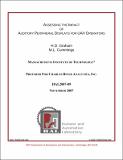| dc.contributor.author | Graham, H. D. | |
| dc.contributor.author | Cummings, M. L. | |
| dc.contributor.other | Massachusetts Institute of Technology. Dept. of Aeronautics and Astronautics. Humans and Automation Laboratory | |
| dc.date.accessioned | 2009-09-18T04:23:20Z | |
| dc.date.available | 2009-09-18T04:23:20Z | |
| dc.date.issued | 2007 | |
| dc.identifier.uri | http://hdl.handle.net/1721.1/46735 | |
| dc.description.abstract | A future implementation of unmanned aerial vehicle (UAV) operations is having a single
operator control multiple UAVs. The research presented here explores possible avenues of
enhancing audio cues of UAV interfaces for this futuristic control of multiple UAVs by a single
operator. This project specifically evaluates the value of continuous and discrete audio cues as
indicators of course deviations or late arrivals to targets for UAV missions. It also looks at the
value of the audio cues in single and multiple UAV scenarios.
To this end, an experiment was carried out on the Multiple Autonomous Unmanned Vehicle
Experimental (MAUVE) test bed developed in the Humans and Automation Laboratory at the
Massachusetts Institute of Technology with 44 military participants. Specifically, two continuous
audio alerts were mapped to two human supervisory tasks within MAUVE. One of the
continuous audio alerts, an oscillating course deviation alert was mapped to UAV course
deviations which occurred over a continual scale. The other continuous audio alert tested was a
modulated late arrival alert which alerted the operator when a UAV was going to be late to a
target. In this case the continuous audio was mapped to a discrete event in that the UAV was
either on time or late to a target. The audio was continuous in that it was continually on and
alerting the participant to the current state of the UAV. It either was playing a tone indicating
the UAV was on time to a target or playing a tone indicating the UAV was late to a target. These
continuous alerts were tested against more traditional single beep alerts which acted as discrete
alerts. The beeps were discrete in that when they were used for monitoring course deviations a
single beep was played when the UAV got to specific threshold off of the course or for late
arrivals a single beep was played when the UAV became late.
The results show that the use of the continuous audio alerts enhances a single operator’s
performance in monitoring single and multiple semi-autonomous vehicles. However, the results
also emphasize the necessity to properly integrate the continuous audio with the other auditory
alarms and visual representations in a display, as it is possible for discrete audio alerts to be lost
in aural saliency of continuous audio, leaving operators reliant on the visual aspects of the
display. | en |
| dc.description.sponsorship | Prepared for Charles River Analytics, Inc. | en |
| dc.language.iso | en_US | en |
| dc.publisher | MIT Humans and Automation Laboratory | en |
| dc.relation.ispartofseries | HAL Reports;HAL2007-09 | |
| dc.title | Assessing the Impact of Auditory Peripheral Displays for UAV Operators | en |
| dc.type | Technical Report | en |
